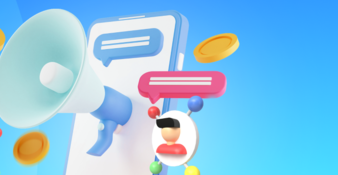How to Carve out Your Ideal Customer Profile (ICP) Using Social Listening

Article summary
In this article, we explain how to build an Ideal Customer Profile with the help of social listening. We walk you through all the necessary steps from initial analysis of your customers and their pain points to the factors needed to be included in the Profile.
3 minute read
The whole power of social lies in the capacity to tune in and get a feel of what people feel about a brand and its competitors. Social listening, listening to what people are saying online, gives marketers the power to get a better grasp on the key opportunities and flaws in your branding.
This social sentiment analysis allows them to understand customer needs and preferences. Data such as customer demographics, psychographics, and online behavior help them carve a clear picture of who the ideal customer is. As people interact with a website or social media, they reveal interesting information about themselves - interests, pain points, and preferences. This can be used to make accurate predictions about their behavior and build an ideal customer profile.
This ideal customer profile (ICP) is useful for qualifying leads and reducing marketing inefficiencies. It feeds marketing strategies and allows the team to build targeted marketing programs that fetch maximum returns.
But carving out an ideal customer profile isn’t an easy task but the efforts will pay off in the long run. The process requires gathering data from key stakeholders like your customer success team, sales team, and marketing teams. However, social listening emerges as the most effective method to build the ICP because it gives you a direct peek into the insightful digital chatter.
In this post, we will share how social listening can be used to build a clear ICP for your business.
1. Draw a Rough Sketch of Your Ideal Customer Profile
Social listening should be used to carve your ideal customer profile. However, for this, you first need to have a rough idea of who your ideal customer is. This is a fictional character who fits your value proposition and has the budget to buy from you. They will likely have a positive experience with your product and have the authority to share their experiences.
To gather information that will feed your ICP, you will need to leverage data from your existing customers, market research, industry reports, competitor analysis, and your team’s expertise. This will help you identify your customer’s demographic and behavioral criteria, thus sketching a rough segment you want to target.
Evaluate your existing customers
Leverage a good social listening tool to spot the attributes of your existing followers and customers. Characterize them by age, interests, professional title, or industry.
For instance, if you are a luxury brand and your audience comprises Gen Z, you’ll know what type of content this cohort prefers to consume.
Analyze competitor audiences
Watch the channels your competitors are active on. What is the type of content they are sharing and who is engaging with it? Also observe how they are interacting with potential customers, influencers, and critics.
At this point, you must also analyze what people are saying about your competition.
Google Alerts is a great tool that allows you to set up alerts for specific keywords.

So, if you are an ecommerce store selling men’s apparel, you could set up alerts for things like “men’s clothing,” “men’s fashion,” and “trendy men’s apparel.” You will get notified each time someone shares content on these topics on social channels like Facebook and Twitter.
Note down the pain points of your customers
Understand what your existing customers want. What are they saying about your product or service? Are they happy with the product or facing issues?
The challenges they are facing when using your product or service will be the ones faced by others too. The more you know about their pain points, the closer it will take you to your ideal customer profile.
Most revenue-centric firms start with determining the ideal customer profile as it allows them to precisely target the pain point through relevant marketing efforts. Such relevant campaigns have a direct impact on a firm’s revenue outcomes.
No wonder, accurately identifying the target audience is a core part of a firm’s revenue marketing strategy. Research reveals that customer-centric CEOs are more profitable than their competitors. A Deloitte research confirms that customer-centric firms are 60% more profitable than those who don’t prioritize customers.
Thus, knowing customer pain points and their challenges is critical to business success.
2. Use a Good Social Listening Tool
Having the right social listening tool in your arsenal will help you leverage advanced social listening capabilities like sentiment analysis, competitor analysis, analytics, industry keyword mentions, and customizable alerts.
Tools like Awario offer exceptional social listening across social media, blogs, forums, and more. The platform lets you track brand mentions, answer customer questions in-app, follow up on positive and negative comments, and build meaningful relationships
It also allows you to discover potential clients looking for your product and turn them into leads and customers by being the first to answer their questions and offer solutions.

Thus, you will get a clear picture of what your ideal customer expects from you. Whether it is building a foolproof marketing strategy or a product pricing strategy, a social listening tool can offer interesting insights into this matter.
For instance, if you are wondering what is product pricing strategy and how a social listening tool like Awario can help with getting to an ideal product price, we can explain.
Social listening allows marketers to get a deep dive into who their customers are and how much they are willing to pay. The insights derived from social listening tools like Awario allow marketers to take the guesswork out of pricing decisions. It also allows them to test their pricing or offer different pricing structures to suit the audience. This can be effortlessly achieved through sentiment analysis that identifies the pain points, frustrations, needs, or desires of your audience.
3. Gain Insights from Social Customer Support
Social customer support is the most effective way to resolve customer questions or concerns. Tweets, Facebook messenger comments, Instagram comments, and messages offer customers an easy and quick way to effortlessly connect with the business.
Here are some interesting statistics for you:
-
From 2020 to 2021, the volume of customers who preferred using social messaging for customer service jumped an impressive 110%.
-
Nearly half of customers engaging with brands on social are reaching out about customer care concerns.
-
79% of customers expect a response to their social media posts within 24 hours.
Besides proving to be a great customer engagement medium, customer support is a goldmine of customer data. Analyzing the interactions your support team has with customers can offer interesting insights about what they think and their preferences, habits, and challenges.
This information should be leveraged to learn more about your audience. Understand what type of concerns they are sharing. What is it they are looking for? Do they have any specific needs? Are they facing an issue when using your product or service?
The answers to these questions will help you determine their pain points and opportunities for improvement.
4. Build the Ideal Customer Profile
Once you have all the information about your audience, it’s time to gather it together and create your ICP.
Work with your marketing and sales team to understand each aspect of your customer profile. Include their needs, problems, and goals. Sketch their buyer journey - from prospect to becoming a loyal customer.
Once the ICP is crafted, the sales and marketing teams should use it to guide their campaigns and interactions.
For instance, if a salesperson knows that the customer is price-conscious, they shouldn’t waste time pitching the premium range to them. Instead, they can start the customer with a basic plan and later upgrade them. Consider incorporating customer journey analytics software to enhance this process by providing crucial insights into customer behavior and preferences, thereby refining the ICP and guiding personalized interactions.
Summing Up
When it comes to building an ideal customer profile, there’s no substitute for knowing your market and target audience like the back of your hand. Social listening makes this task easy by giving marketers a deep dive into the target market, enabling them to create an accurate ICP and convert leads through relevant marketing campaigns.
If you are looking to optimize your marketing efforts and build effective campaigns, we would suggest starting with carving your ideal customer profile through social listening. Go ahead and use the information shared in this post to take your business to the next level.













